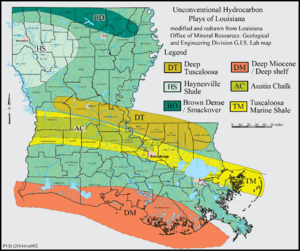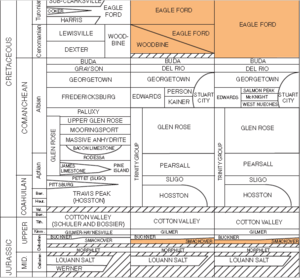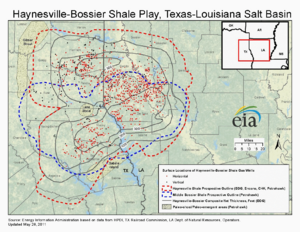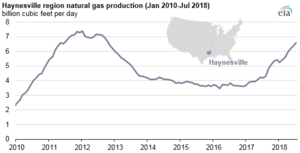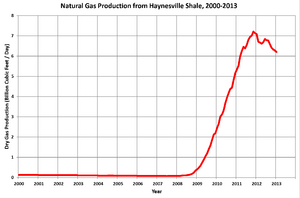Haynesville Shale facts for kids
The Haynesville Shale is a special kind of rock formation that lies deep underground. It's found in parts of southwestern Arkansas, northwest Louisiana, and East Texas. This rock layer is usually 10,500 to 13,000 feet (about 3 to 4 kilometers) below the surface, which is super deep! It's part of a bigger rock group called the Haynesville Formation.
The Haynesville Shale covers a huge area, about 9,000 square miles (23,000 square kilometers), and is typically 200 to 300 feet (60 to 90 meters) thick. It's covered by sandstone and sits on top of limestone.
What makes the Haynesville Shale so important? It holds a lot of natural gas, which is a type of energy. This gas is called "shale gas" because it's trapped in this specific kind of rock. People knew there was gas here before 2008, but it was too expensive to get out. Thanks to new technologies like hydraulic fracturing (often called "fracking") and directional drilling, it became possible to get the gas out of the Haynesville Shale in a way that makes sense financially.
Contents
Where the Name Comes From
The Haynesville Shale gets its name from the town of Haynesville in Louisiana. Geologists named the larger rock group, the Haynesville Formation, after this town. Even though they were once thought to be the same, the Haynesville Shale and another rock layer called the Bossier Shale are now known to be separate formations.
What the Haynesville Shale is Made Of
The Haynesville Shale is mostly made of a type of rock called mudstone. This mudstone can be different in various places. It often contains tiny bits of clay and calcite (which is found in limestone). Sometimes, it also has small amounts of dolomite.
Scientists have found tiny fossils in the Haynesville Shale, like parts of coccoliths (tiny sea creatures), bivalves (like clams), and gastropods (like snails). These fossils help tell us about the ancient environment where the rock formed.
The Haynesville Formation, which includes the Haynesville Shale, also has other rock layers like limestone and sandstone. These layers formed in different environments, like coastal areas and shallow seas.
How Old is the Haynesville Shale?
Based on the fossils found and how the rock layers are positioned, the Haynesville Shale is very old! It formed during the Jurassic Period, specifically in a time called the Kimmeridgian Stage. This means it's about 151 to 157 million years old. Imagine, dinosaurs were walking the Earth when this rock was forming!
How the Haynesville Shale Formed
The Haynesville Shale formed in a special kind of ancient basin (a bowl-shaped depression) on a continental shelf. This area was covered by relatively shallow water. The mudstone that makes up the shale settled as a wide, continuous layer across this basin.
The basin was somewhat closed off by ancient landforms. To the north, there were shallow coastal waters and dry coastal plains. To the west, there was a large platform made of carbonate rocks. To the south, there was an ancient island called "Sabine Island," which is now buried deep underground in Texas.
Because these landforms created a restricted basin, ocean currents couldn't easily flow through. This often led to "anoxic" conditions, meaning there was very little oxygen at the bottom of the water. When plants and animals died and sank to the bottom, the lack of oxygen helped preserve their organic matter. This organic matter eventually turned into the natural gas we find today in the Haynesville Shale.
Natural Gas from the Haynesville Shale
The Haynesville Shale became very important in 2008 as a major source of shale gas in East Texas and Louisiana. To get the gas, wells are drilled very deep, from 10,000 feet (3,000 m) to 13,000 feet (4,000 m). The rock layer gets even deeper as you go further south.
In 2008, people thought the Haynesville Shale might be the biggest natural gas field in the United States (excluding Alaska and Hawaii), with an estimated 250 trillion cubic feet (7.1×1012 m3) of gas that could be recovered. Later, in 2009, estimates were updated to about 75 trillion cubic feet, making it the second-largest in the US after the Marcellus Formation.
Gas production from the Haynesville Shale really took off after 2008. It reached its highest production in November 2011, producing 7.2 billion cubic feet of gas per day! In January 2013, it was still producing 6.2 billion cubic feet per day, which was about 9.3% of all the gas produced in the US at that time.
Other parts of the Haynesville Formation also produce oil and gas. For example, oil and gas are found in limestone layers that formed along the edge of the ancient continental shelf.
How Much Gas is There?
The US Energy Information Administration has estimated the amount of gas that can be recovered from the Haynesville Shale:
- In 2010: 24.5 trillion cubic feet of gas
- In 2011: 29.5 trillion cubic feet of gas
About a Documentary Film
A documentary film called "Haynesville: A Nation's Hunt for an Energy Future" was made about the search for natural gas in the Haynesville Shale. It talks about how people bought rights to drill for minerals and how the gas from this area could affect energy for the country and the world.
|


